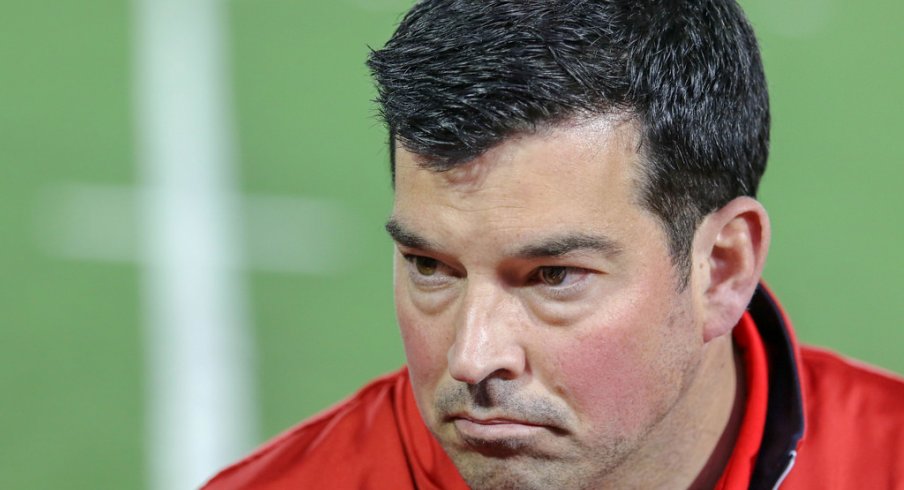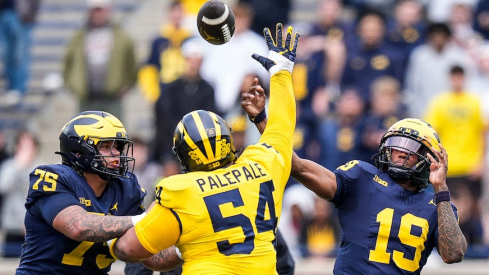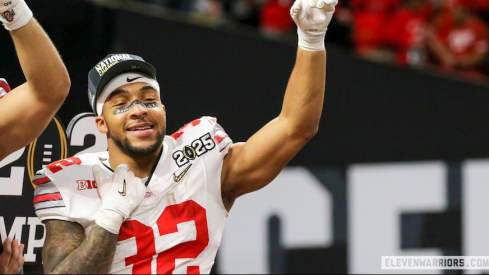With Ohio State's fall camp already underway and numerous questions about the status of head coach Urban Meyer still unanswered, it's fair to begin examining how his absence may be felt on the field. While offensive coordinator Ryan Day is tasked with leading the program in Meyer's absence, many fans have begun to wonder aloud what changes the former protege of Chip Kelly may make given his recently added responsibilities.
Luckily, Day will be able to lean on the counsel of two former college head coaches in Kevin Wilson and Greg Schiano, as well as four other assistants with coordinator experience in Alex Grinch, Greg Studrawa, Billy Davis, and Taver Johnson. Given Day's focus on the offensive side of the ball and the presence of such a talented staff under Schiano, it's unlikely that the Buckeye defense will look much different than it had with Meyer at the helm.
But despite finishing seventh nationally in total yards last fall, much of the focus had already been on Day's offense throughout the offseason, thanks to the departure of record-setting quarterback, J.T. Barrett. With presumed starter Dwayne Haskins featuring a slightly different skill set than his predecessor, many had expected to see big changes coming to the Ohio State playbook in 2018.
But as we saw in the Spring Game last April, the system looked largely the same, relying on many of the same concepts featured in 2017. The run game still relied heavily on the same zone concepts like Crunch (below) with occasional gap schemes mixed in.

There were some tweaks to the passing game, but most came in the form of disguising core concepts like Saints in new ways rather than installing different ones altogether. Instead of rebuilding the system from scratch, it appears as though Meyer, Day, and Wilson elected to maintain their positive momentum from the prior year despite the stylistic differences between their two signal-callers.
But even if Day had desired to rebuild the system in an effort to better suit Haskins, there simply isn't enough time to do so at this point. Given the NCAA limitations placed on how much time coaches can spend with their players, it's extremely difficult to install the dozens of concepts that make up a modern playbook in just 25 preseason fall practices.
While there is always room to add a wrinkle here or there as the season progresses, much of the system's foundation was laid during the 15 spring sessions. With the basics already in place, the team is able to focus on specific scenarios such as goal-line and two-minute situations during fall camp.
It's in these situations, however, where we might begin to see a difference with Day in command. Though Meyer never called plays directly, his veto power could often be felt in close games. Specifically, when facing 3rd & short (1-3 yds to go), Meyer relied heavily on the quarterback run game, taking full advantage of Barrett's ability to navigate between the tackles and fall forward.
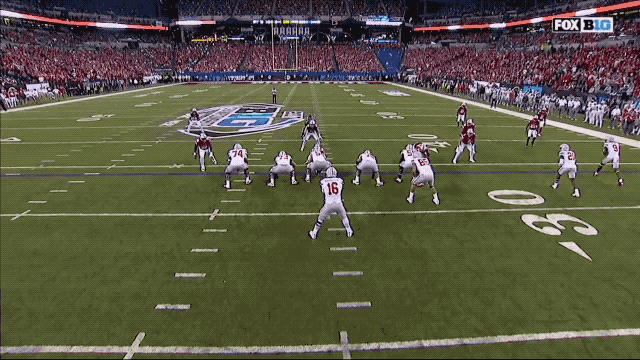
| Year | % Run Plays | % Pass Plays | 3rd & Short Conversion Rate |
|---|---|---|---|
| 2012 | 78.2% | 21.8% | 58.7% |
| 2013 | 76.3% | 23.7% | 59.3% |
| 2014 | 80.6% | 19.4% | 54.2% |
| 2015 | 80.6% | 19.4% | 62.9% |
| 2016 | 83.3% | 16.7% | 75.0% |
| 2017 | 77.9% | 22.1% | 64.7% |
| TOTAL | 79.6% | 20.4% | 62.4% |
Not only did Ohio State run the ball nearly 78% of the time in such scenarios last fall, continuing a pattern seen throughout Meyer's tenure, but Barrett was the ball-carrier on 25 of their 53 rush attempts on 3rd & short, picking up 16 of the 36 converted first downs. While many often second-guessed Meyer's reliance on the arithmetical advantage of using the QB as a runner, the results are difficult to argue given the team's consistent ability to convert on 3rd downs.
Meyer's Buckeyes finished with the 6th-best 3rd down conversion rate in the nation in 2017, picking up the first down 46.49% of the time. However, without Barrett's legs upon which to rely, questions remain about how often Day will ask Haskins to carry the ball in such situations.
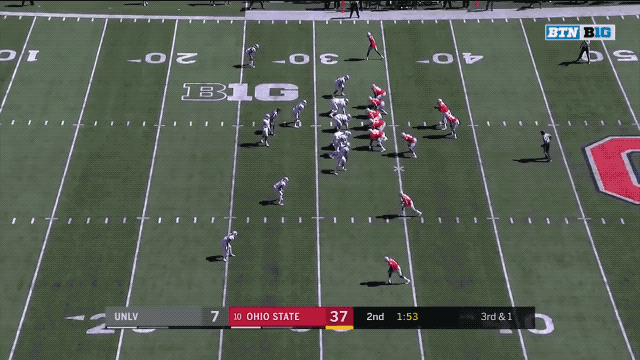
Despite limited attempts, Haskins proved capable of carrying out option reads and picking up needed yardage, yet he's clearly not as comfortable doing so. But though Day spent last season working for Meyer, it's unlikely that he'll rely on the quarterback run game quite as heavily.
Day was promoted to primary play-caller this past offseason, but it wasn't to be the first time he'd held coordinator duties. Though he didn't call plays in his three seasons working in the NFL, he spent the three prior to that running the offense for Steve Addazio at Temple and Boston College.
Addazio, of course, descends from Meyer's coaching tree having worked for him at Florida and has often featured a running game built around the quarterback. In fact, while Day worked for Addazio, they often featured a runner at the quarterback position and even had a 1,000-yard rusher at the spot with Tyler Murphy at BC in 2014.
| Team | Year | % Run Plays | % Pass Plays | 3rd & Short Conversion Rate |
|---|---|---|---|---|
| Temple | 2012 | 67.5% | 32.5% | 52.5% |
| Boston College | 2013 | 56.8% | 43.3% | 52.8% |
| Boston College | 2014 | 69.1% | 30.1% | 61.9% |
| Total | 63.7% | 36.3% | 55.6% | |
But despite all the similarities between the two systems, Day's offenses away from Columbus were far more balanced in 3rd & short situations. Even with the talented Murphy under center, the Eagles still ran the ball less frequently than Meyer's teams ever have at Ohio State, with a conversion rate that nearly matched the one found in Columbus.
But as noted above, Day will still have Wilson at his side to help direct the offense. While the former Indiana head coach has directed offenses for two decades, his history in 3rd & short scenarios while in Bloomington echoes that of Day far more than that of their boss.
| Year | % Run Plays | % Pass Plays | 3rd & Short Conversion Rate |
|---|---|---|---|
| 2011 | 84.2% | 15.8% | 68.4% |
| 2012 | 50.0% | 50.0% | 59.2% |
| 2013 | 64.1% | 35.9% | 56.6% |
| 2014 | 76.1% | 23.9% | 50.0% |
| 2015 | 73.6% | 26.4% | 56.6% |
| 2016 | 66.7% | 33.3% | 56.1% |
| TOTAL | 68.1% | 31.9% | 57.5% |
With the exception of Tre Roberson in 2011, Wilson never featured a particularly athletic quarterback with the Hoosiers. Instead, big pocket passers like Nate Sudfeld and Richard Lagow took the majority of snaps with Zander Diamont occasionally spelling the duo to provide a dose of athleticism.
Diamont, of course, nearly led his team to an upset win over the Buckeyes in 2015, thanks in large part to his 98 rushing yards that day. But even with a shifty runner capable of picking up short-yardage first downs, Wilson still relied on quarterback runs less frequently than Meyer, even finding a perfect 50/50 split when Sudfeld took over for the injured Roberson in 2012.
Though there have long been rumors of a similar package to Diamont's for Tate Martell, a similarly undersized, yet agile runner, it's far more likely Day and Wilson will rely strictly on Haskins in such situations. A likely substitute for the option run game is more short crossing routes like Mesh, as we saw in the Michigan game when Haskins was forced to appear in a relief role.

But the concepts that fit the existing personnel most are run/pass options that still allow Day to get the ball into the hands of his most dangerous weapons, running backs J.K. Dobbins and Mike Weber or slot receivers Parris Campbell and K.J. Hill. Simply adding a bubble screen to a designed handoff allows Haskins to take advantage of his skill set as a passer while keeping the option element Meyer so loves.

Wilson relied heavily on such RPOs while at Indiana, leading to many of the 3rd down passes noted above. In addition to bubble screens to the slot and backside hitches to the X receiver, Wilson also liked to combine frontside slants with runs into the boundary, stressing linebackers focused on fitting run gaps.
Given the time left until Oregon State comes to town on September 1st and the uncertainty around the future of his boss, Day has neither the time nor the mandate to make the changes some might expect. But just because we won't be seeing a brand new playbook doesn't mean the offense will look the same as it had, especially on 3rd & short.
